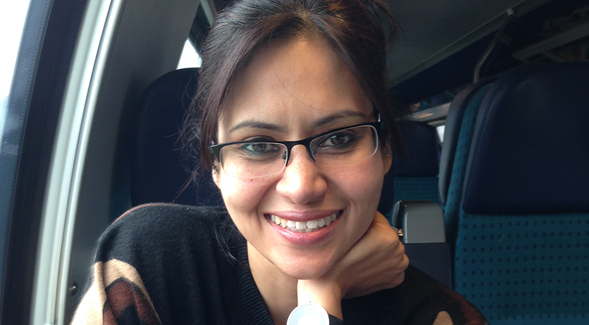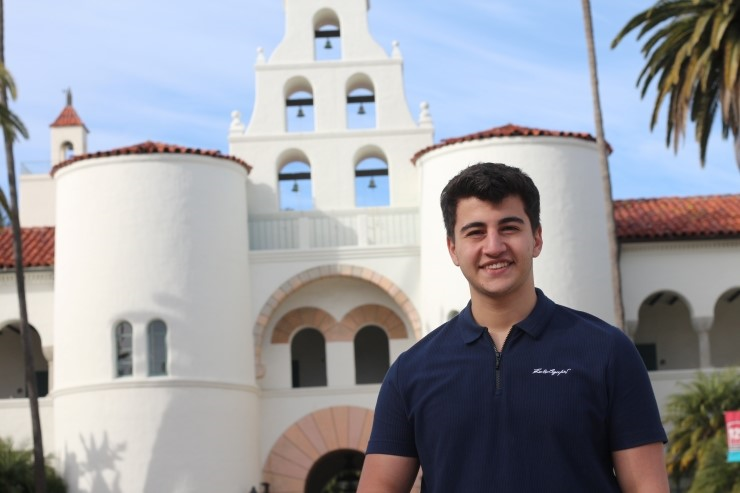Creating Alternative Communication Highways
SDSU researcher Mahasweta Sarkar studies the use of brain-computer interface technology.

Mahasweta Sarkar is on a mission to create life-changing connections. The San Diego State University associate professor in the Department of Electrical and Computer Engineering is investigating whether biosensors implanted in the brain could transmit signals wirelessly to paralyzed arms in individuals with spinal cord injuries. The primary goal is to restore mobility in the upper limbs of such individuals.“I am hopeful that my work within the CSNE will encourage and motivate the next generation of both male and female scholars to pursue neuroengineering careers.”
Sarkar is part of the Center for Sensorimotor Neural Engineering (CSNE), a collaboration between researchers from SDSU, the University of Washington and the Massachusetts Institute of Technology that is supported by $35 million in funding from the National Science Foundation (NSF).
SDSU's participation in the multi-university consortium underscores its commitment to research collaboration. The SDSU Engineering and Interdisciplinary Sciences Complex, slated to open early next year, will provide even more opportunities for faculty and students to find innovative ways to collaborate across labs and disciplines.
She and her collaborators are using “glassy carbon” electrodes developed by Sam Kassegne, a fellow CSNE researcher at SDSU, to capture brain signals. These bio-compatible electrodes are surgically implanted in the human brain where they record commands that the brain routinely transmits to the limbs.
In a healthy individual, these signals travel through the spinal cord and associated nerves to the intended parts of the body. For instance, if the brain generates a signal for the hand to pick up an item from a table, muscles in the hand interpret that signal and move to execute the brain’s command.
In patients with spinal cord injuries, the body’s natural communication highways are damaged. Although the brain is capable of producing the same command, it doesn’t reach the hand.
Bypassing natural pathways
Sarkar and her team are working to develop an artificial communication highway that avoids damaged nerves in bypassing the natural journey brain signals take through the spinal cord. Her method would allow the signals captured by the implanted electrodes to be passed to a low-power transmitter, which would wirelessly send the brain signals to a muscle stimulator located on the paralyzed limb.Before the technology can be tested in the human body, it must undergo rigorous testing to determine how deep inside the brain tissue the wireless transmitters will have to be implanted, as well as how much power can be used to transmit the brain signals without causing damage to the brain.
“Right now, we are trying to figure out how the combination of blood, water, tissue fluid, tissue and bones affects the wireless signals," said Sarkar. “To do that, we are testing the performance of the low-power neural transmitters in chemical solutions that mimic the body’s natural environment.”
So far, the team has focused on studying the transmission from a single implantable neural transmitter. Sarkar hopes to transmit signals from many such transmitters within a year and believes her current research could be applied to humans within the next decade.
Sarkar has presented her work at numerous scientific conferences and published her research in several recent academic journal articles. She won the best paper award in 2013 for "Ultra Wideband Transceiver Design for Compact and Implantable Medical Devices," work that appeared in the Proceedings of the International Conference on Communications Systems and Technologies.
Inspiring the next generation
In addition to her research work, Sarkar was recently tasked by the CSNE to lead its education efforts for the next generation of neural engineers. In her role as the CSNE’s education co-director, Sarkar hosted the first-ever Young Scholars Program (YSP) at SDSU over the summer.The free-to-attend, NSF-funded two-week summer camp allowed 14 local middle and high school students to explore the neuroengineering field’s opportunities for both patients and researchers alike.
As part of the camp, students programmed a computer chip to rotate a motorized propeller with just the power of their minds. They utilized a headset that captured EEG signals from the brain, then wrote software code to wirelessly translate the headset wearer’s level of attention into rotation by the motorized propeller.
“The camp consisted of a pool of really bright future scholars, and I thought it was remarkable that an equal number of boys and girls participated,” said Sarkar. “I am hopeful that my work within the CSNE will encourage and motivate the next generation of both male and female scholars to pursue neuroengineering careers.”



